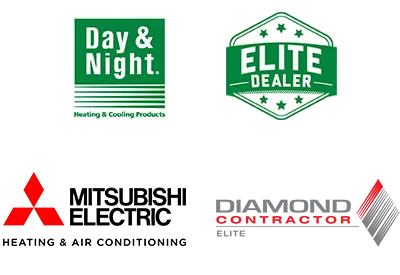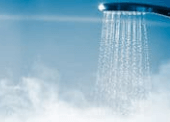
A cold shower when you don’t want one is not a fun experience, but it doesn’t have to be something you suffer through every day. Instead, you can keep your shower and water heater in great shape by knowing more about how long it normally takes to heat water and the main reasons why a shower might not give you hot water.
If your water heater is working correctly and you haven’t used up all the hot water in its tank already, your shower should only take a couple of minutes to reach the temperature you want. Since your water heater tank will store hot water, it doesn’t take long for the hot water to reach your shower.
When you have to wait longer than a couple of minutes for hot water, your water heater’s tank may have run out of it. However, if your tank isn’t out of hot water, you might need a hot water heater repair to fix whatever issue is preventing hot water from reaching your shower.
If your water heater’s tank runs out of hot water, you’ll have to wait for it to heat the water again before you can take a hot shower. Usually, water heaters run out of water due to excess use, such as when someone takes a very long shower or multiple people take showers in a short period. Whatever the cause, it will probably take 30 minutes to 80 minutes for your water heater to completely heat the water in its tank.
If your shower always takes a long time to heat up, the cause could be due to a few different issues. Fortunately, water heater repair services can solve most issues that affect a shower’s temperature. Learn more about the top five reasons showers take a long time to heat up below:
Sometimes, a shower that takes forever to heat up is due to the distance between the shower and the water heater. Basically, when your water heater is far from your shower, the hot water will take longer to run through your pipes and reach your shower head. Wider than normal pipes can also slow down your hot water. A trained plumber can usually solve this issue and ensure you receive hot water faster.
If you don’t regularly maintain your water heater, sediment inside your tank and pipes will build up. Over time, minerals like calcium and magnesium can block your water heater’s heat mechanism and slow the heating process. This issue can usually be fixed by a full tank flush from a trained plumber, as this service is designed to get rid of sediment build-up. Additionally, scheduling regular water heater flushes can stop the issue from coming back.
Normally, a water heater is set to a temperature between 120 and 140 degrees. If someone has lowered your water heater’s thermostat to a temperature below 120, your water heater will struggle to give you hot water. Additionally, temperatures lower than 120 can cause bacteria to grow in your water and affect your health. If your thermostat is set lower than 120, raise it back to that temperature and see if it solves your issue.
Your water heater’s dip tube is responsible for sending cold water to the bottom of your tank, where it can be heated. If your dip tube is broken or malfunctioning, the cold water can be directed to the top of the tank, causing it to mix with the hot water. As a result, you’ll notice a dip in your shower’s maximum temperature. During a water heater repair, a plumber can solve this issue by repairing or replacing the dip tube.
When you have a lot of people taking showers or using hot water for other purposes in your home, you’ll run out of hot water faster. If you constantly have to take cold showers due to too many people showering before you, your tank’s size is the issue. To ensure your water heater can handle the demand, you’ll either need to upgrade to a larger tank or invest in a tankless water heater that delivers hot water instantaneously.
If you’re looking for water heater repair near you in Novato, Vacaville, or the surrounding Northern California area, turn to Peter Levi. Our certified plumbers can inspect and repair your water heater when you’re not receiving hot water. They can also replace your unit with a more efficient water heater or a tankless model when your unit is past the point of repair. Additionally, you can review our coupons to ensure you receive the best deal on any of our water heater repair services.
Learn more about our water heater repair services today. If you have any questions or want to schedule an appointment, please contact us.

GM, Peter Levi Plumbing, Heating, Cooling and Drains
With over twenty years of expertise in HVAC, plumbing, and drain services, I specialize in delivering high-quality solutions for residential needs. From high-end heating and air conditioning systems to comprehensive plumbing and underground construction projects, I am committed to providing exceptional service and reliability for every household. Whether it's an emergency repair or a planned home upgrade, my focus is always on delivering the best customer experience.
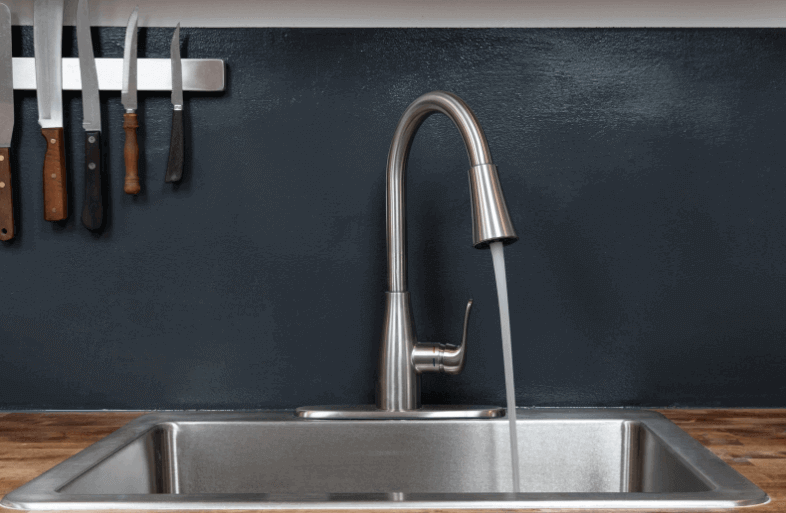
No one wants to turn on their faucet and see a stream of cloudy or brown water. Water is too important to our daily lives to be unusable when it flows into our homes. When we see discolored water, we know there’s a problem, but why, and what can we do to fix it?
Let’s explore a few reasons your water may be tainted and whether there are dangers associated with discoloration.
Discolored water is a sure sign of poor water quality, but you’ll need to know why your water is discolored to properly solve the problem. Your water may be discolored for any of the following reasons:
When a water main breaks or the water lines are flushed, the pressure of the water flow changes. The rust, dirt, and sediment built up in the water line is disturbed and picked up by the water entering your home.
During droughts, fresh surface water comes into contact with sediment at the bottom of the river or stream supplying water. Extreme weather conditions can also cause problems for homeowners that use a private well. Excessive and heavy rains will trigger fluctuations in the water table, and an excess of iron will seep into the water supply, causing discoloration.
The most common reason water discoloration occurs is a broken water pipe or a recently replaced pipe. Rust from the broken pipe slips into the water supply turning it brown. Replacing a pipe can also change the water pressure and loosen deposits from the piping.
Discolored water is usually not considered dangerous. The issue is usually due to a sediment or iron build-up, and the concentrations are too low to be considered harmful. However, you could potentially ingest bacteria like mold or mildew, which will have an adverse effect on your health. As a result, you may want to wait to drink your home’s water before it’s fixed.
As soon as you see the discolored stream, you should spring into action and have the issue rectified. The following methods are extremely helpful in solving water discoloration:
If you need water discoloration services near you in Novato, Vacaville, or the surrounding Northern California area, Peter Levi can make sure your water is safe and running clear. Whether you need a hot water heater replaced or a filtration system installed, our team can provide a solution fitting your budget. We also offer multiple coupons to ensure our clients get an excellent deal.
Learn more about our plumbing and water heater services today. If you need service, please make an appointment online or call us at 800.605.5713.

GM, Peter Levi Plumbing, Heating, Cooling and Drains
With over twenty years of expertise in HVAC, plumbing, and drain services, I specialize in delivering high-quality solutions for residential needs. From high-end heating and air conditioning systems to comprehensive plumbing and underground construction projects, I am committed to providing exceptional service and reliability for every household. Whether it's an emergency repair or a planned home upgrade, my focus is always on delivering the best customer experience.
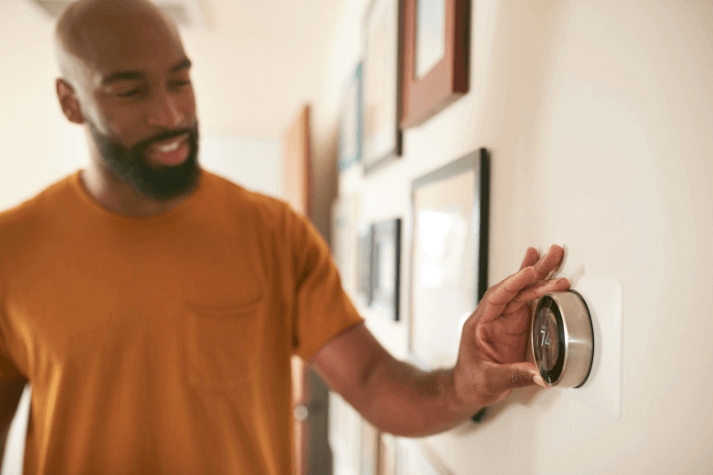
Your home’s thermostat is one of the most important components of your HVAC system, as it measures and controls your home’s temperature. When you have an inaccurate thermostat, your HVAC system won’t generate enough cool or hot air to match your setting. Fortunately, knowing the five main signs of an inaccurate thermostat can help you get ahead of the problem and solve it before it impacts your quality of life.
The most obvious sign that you have an inaccurate thermostat is if your home feels colder or warmer than the temperature you’ve set. For example, if you’ve set your thermostat to 70 degrees, but you’re sweating indoors and your home feels like it’s in the 80s, your thermostat likely has an issue.
While you can usually tell if a thermostat is inaccurate based on how a room feels, you could also compare your thermostat’s reading to a separate portable thermostat’s reading. If the two thermostats show different temperatures, an HVAC technician will need to inspect your thermostat to find out what’s causing the inaccurate thermostat reading.
If your thermostat is installed near a place in your home where the temperature consistently swings, your thermostat’s reading is likely off. For instance, a thermostat near a door will likely experience various temperature swings as people enter and exit your home. A thermostat exposed to direct sunlight can also be affected, as the sunlight can make the thermostat believe your home is warmer than it actually is.
Typically, this issue can be solved by installing the thermostat in a new location. However, if your home isn’t properly zoned, you could also need home zoning services to prevent temperature fluctuations.
Another sign that you have an inaccurate thermostat is if you’re still using a mercury-based thermostat that’s not level. These older thermostats are usually installed in older homes and need to stay level to provide an accurate reading.
If you have one of these thermostats and it’s not in a level position, you’ll need to adjust it back to a level position to get an accurate reading. However, it’s usually best to replace the thermostat and invest in programmable thermostat installation services to receive the convenience and energy-saving benefits of modern thermostats.
Modern thermostats rely on sensors to detect your home’s temperature and provide an accurate reading. When these sensors are dirty or damaged, your thermostat can’t properly determine the correct temperature. As a result, a visibly damaged or dirty sensor is a sign you have an inaccurate thermostat. While you can fix a dirty sensor by cleaning the inside of your thermostat and recalibrating it afterward, you’ll need an HVAC professional to repair a damaged sensor.
Thermostats usually have a life expectancy of about ten years. If you have an old thermostat past its expected lifespan, it could be providing inaccurate readings. Instead of repairing an old thermostat, it’s often better to replace it with a new model, especially if you don’t have a smart or programmable thermostat.
With programmable thermostat installation, you can receive all the benefits of the newest temperature-control technology. For example, programmable thermostats give you the opportunity to set your thermostat on a schedule that saves energy while you’re away from home. Many new thermostats also pair with phones and other devices, meaning you can conveniently control your home’s temperature even when you’re away.
If you’re looking for thermostat repair, replacement, or installation services near you in Vallejo, Benicia, Fairfield, Novato or the surrounding Northern California area, turn to Peter Levi. Our HVAC professionals can inspect your inaccurate thermostat and provide a solution that fixes it for you. You can also turn to us for smart or programmable thermostat installation when you want to upgrade your existing thermostat and receive the most accurate reading possible. Additionally, you can review our coupons to ensure you get a great deal.
Learn more about our programmable thermostat installation and repair services today. If you have any questions or want to schedule an appointment, please contact us.

GM, Peter Levi Plumbing, Heating, Cooling and Drains
With over twenty years of expertise in HVAC, plumbing, and drain services, I specialize in delivering high-quality solutions for residential needs. From high-end heating and air conditioning systems to comprehensive plumbing and underground construction projects, I am committed to providing exceptional service and reliability for every household. Whether it's an emergency repair or a planned home upgrade, my focus is always on delivering the best customer experience.

If you own a cat or a dog, you probably want to give them the best life possible. Besides feeding them their favorite foods, buying them a comfortable bed, and playing with them throughout the day, you can make sure they're as comfortable as possible by keeping your home at the best temperature for them. After all, you don’t want your furry companion to be too cold or hot. Fortunately, it’s fairly easy to keep your home at the right temperature when you know how to pick the right temperature settings for dogs and cats.
While it’s a good idea to raise your home’s temperature in the summer and lower it in the winter while you’re away from home to reduce energy usage, it’s not always a great idea if you own a pet. For example, it’s usually smart to raise your thermostat past 80 degrees in the summer when you’re not at home, but that thermostat setting can be a bit too hot for your pets.
In the same way, you won’t want to set your home at 60 degrees or colder, as this can be too cold for cats and other animals. Learn more about the right temperature for your pets during the summer and winter below:
During the summer, it’s typically best to keep your home between 75 and 78 degrees at most times for your cat or dog. However, depending on your dog breed, you may be able to bump it up to 82 degrees (but no higher!) when you’re away to save on energy costs. For cats, you can set your home to the mid-80s while you’re gone, as most cat breeds tend to tolerate higher temperatures more easily.
In the winter, you can have your home cooler to save energy and still keep your cats and dogs comfortable. Usually, the right winter temperature for dogs is between 69 and 72 degrees when you’re at home. While you’re away, you can sometimes bump it down to the lower 60s (but now lower) if you only own a dog and it has a longer coat of fur.
When you own a cat, you’ll never want to set your thermostat below the 70 to 72-degree temperature range, as cats struggle to maintain their natural body temperature below 70 degrees. That being said, if you like your home toasty warm during the winter, you’ll be happy to know that most cats can be comfortable in temperatures up to 88 degrees.
It’s important to remember that the recommended temperature ranges listed above aren’t right for every pet. While most cats and dogs will be happy at the temperatures above, some factors can affect the right temperature for your pet. The main factors you’ll want to consider when choosing the right temperature for your pet include:
Since these factors can impact what temperature is right for your pet, it’s best to consult with your veterinarian on their temperature recommendation. Additionally, if you have any exotic pets, you’ll also want to check with a vet about the right thermostat settings.
While we all want to be great pet owners, it’s easy to forget to change the thermostat before you leave for work or remember what temperature is right for your animal. With a programmable or smart thermostat, you can solve these issues, as these thermostats will automatically adjust your thermostat on a schedule. Additionally, some smart thermostats allow you to change the temperature while you’re away from home, ensuring you can always keep an eye on your home’s temperature and adjust as needed.
If you’re looking for programmable thermostat installation services near you in Novato, Vacaville, or the surrounding Northern California area, turn to Peter Levi. With our trained HVAC technicians in your corner, we can help you select the right programmable thermostat for your home and your pet. After you decide on a thermostat, we can install it for you to ensure you can always easily control the temperature of your home.
Learn more about our smart and programmable thermostat installation services today. If you have any questions or want to schedule an appointment, please contact us.

GM, Peter Levi Plumbing, Heating, Cooling and Drains
With over twenty years of expertise in HVAC, plumbing, and drain services, I specialize in delivering high-quality solutions for residential needs. From high-end heating and air conditioning systems to comprehensive plumbing and underground construction projects, I am committed to providing exceptional service and reliability for every household. Whether it's an emergency repair or a planned home upgrade, my focus is always on delivering the best customer experience.
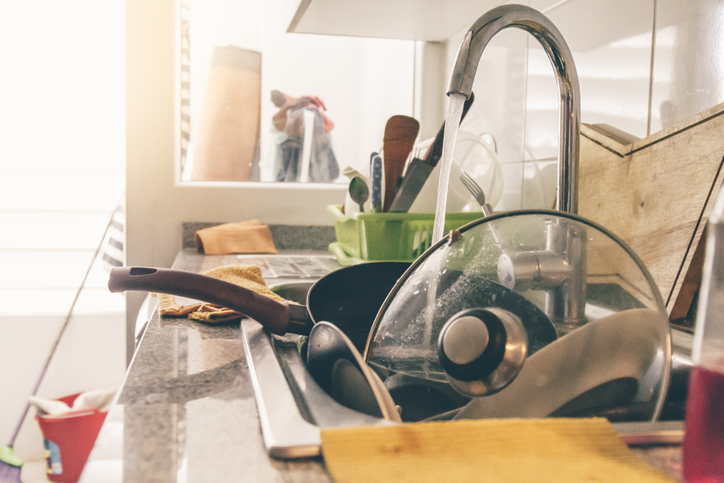
Dealing with a stinky kitchen sink can be frustrating. Not only does it create an unpleasant atmosphere in your home, but it can also be embarrassing when guests come over. Fortunately, understanding the causes and implementing effective remedies can help you tackle this common issue. In this blog post, we'll explore the reasons behind a smelly kitchen sink and provide practical tips to fix it
Before diving into the remedies, it's crucial to identify the source of the odor. Several factors can contribute to a foul smell emanating from your kitchen sink, including:
Now that we understand the potential causes, let's explore effective remedies to combat your stinky sink:
A smelly kitchen sink doesn't have to be a permanent nuisance in your home. By understanding the causes and implementing these simple remedies, including the option of professional drain clearing, you can eliminate unpleasant odors and enjoy a fresh and clean kitchen sink. Remember, if the odor persists despite your efforts, or if you encounter persistent clogs, it's advisable to consult our team of plumbing experts at Peter Levi to address any underlying issues effectively.

GM, Peter Levi Plumbing, Heating, Cooling and Drains
With over twenty years of expertise in HVAC, plumbing, and drain services, I specialize in delivering high-quality solutions for residential needs. From high-end heating and air conditioning systems to comprehensive plumbing and underground construction projects, I am committed to providing exceptional service and reliability for every household. Whether it's an emergency repair or a planned home upgrade, my focus is always on delivering the best customer experience.
If your home has hard water, you’ve probably noticed brownish stains in your sink, residue on your dishes no matter how often you wash them, and a reddish tint to your drinking water. While hard water isn’t dangerous to your health, it can seriously hurt your plumbing system if left unchecked. Since old pipes can contribute to higher hard water levels and are more likely to be damaged by hard water, it’s essential to know why an old pipe replacement can potentially reduce hard water.
Hard water refers to water with high levels of mineral content, with the common minerals being magnesium and calcium. Over time, these high levels of magnesium, iron, and calcium can cause rust in your pipes, sinks, and other areas that come into contact with the water.
When your home has hard water running through its pipes, it can cause various problems. For example, hard water can give the water that comes out of your shower and taps a reddish look. This water discoloration is due to rust build-up, which can leave brownish stains in your sinks. Additionally, high rust or iron levels in your water can cause your clothes to feel stiff after a wash and your dishwasher to leave residue on your dishes.
Besides being unsightly, hard water can damage your plumbing system over time. As hard water passes through your plumbing system, it will leave behind minerals that will build up inside your appliances, pipes, and fixtures. This mineral build-up can damage pipes, reduce your water pressure, corrode your water heater’s anode rod faster, and clog your drains.
Typically, hard water is caused by high concentrations of magnesium and calcium in a home’s water source. Homes that rely on groundwater usually have hard water since groundwater passes through soil and rock, transporting the minerals in these substances into the groundwater supply.
While groundwater is usually the cause of hard water, some old pipes can also contribute to your home’s hard water levels and harm your water’s quality. If your pipes were installed before 1975, they were likely galvanized pipes made out of steel and coated with zinc. Over time, water passing through the pipes will corrode their walls and cause deposits of iron and other minerals to separate from the pipe. These deposits will then increase your water’s hardness and make your pipes corrode faster.
When you have galvanized pipes installed before 1975, you can likely benefit from an old pipe replacement. Since older pipes are more susceptible to corrosion due to hard water and can even raise your hard water levels, an old pipe replacement can help you reduce hard water in your home. Besides lowering your hard water levels, swapping out old pipes for new, more durable ones can reduce the risk of needing a pipe repair or replacement in the future.
Though old pipe replacement services can be a helpful way to reduce hard water, they won’t eliminate it entirely, especially if your home uses groundwater as its water source. Another way you can further reduce hard water levels is to invest in water softening services.
With water-softening services, a plumber will install water-softening solutions in your home to improve your home’s water quality. With one of these solutions installed in your home, it will remove minerals like magnesium and calcium from your water to reduce your water’s hardness. By lowering your water’s hardness, water conditioning solutions help to increase your plumbing system’s lifespan and reduce the adverse effects of hard water.
We recommend talking to your local plumbers about the water quality you would like to achieve. Softening systems eliminate hard water, while professional-grade filters can help purify your water. With the right support, you could get bottle-like quality from the water at your kitchen faucet.
If you’re looking for a plumber near you in Vacaville, Fairfield, Vallejo, Benicia, or surrounding areas, turn to Peter Levi. Our certified plumbers regularly provide hard water solutions to homeowners in the area. With our plumbing services in your corner, you can replace old pipes and receive water-softening solutions. We also offer multiple coupons to ensure the services you receive from us fit your budget.
Learn more about our water line replacement and water softening services today. If you have any questions or want to schedule an appointment, please contact us.

GM, Peter Levi Plumbing, Heating, Cooling and Drains
With over twenty years of expertise in HVAC, plumbing, and drain services, I specialize in delivering high-quality solutions for residential needs. From high-end heating and air conditioning systems to comprehensive plumbing and underground construction projects, I am committed to providing exceptional service and reliability for every household. Whether it's an emergency repair or a planned home upgrade, my focus is always on delivering the best customer experience.
When an AC system is reaching the end of its life, it will struggle to cool your home, raise your energy bills, and make loud noises. An older AC system will also need more frequent repairs, meaning you’ll have to shell out more money to keep your AC running. Typically, AC systems last between 15 to 20 years. As they age, they’ll use more energy and need more repairs.
If your AC is starting to break down or is over 15 years old, it can save you money to replace your old unit with a new system.
While you might want to delay replacing your old AC due to the costs of a new unit and installation services, keeping an old unit around can cost you more money in the future. By replacing your system, you can reduce AC repair costs, properly size your unit for your home, and increase your home’s energy efficiency. Learn more about how all these factors can save you money when you invest in a new AC installation below:
As an air conditioner ages, it often stays on longer to cool your home effectively. This inefficiency increases energy usage, directly impacting your monthly energy bills. In addition, older AC units usually have a lower Seasonal Energy Efficiency Ratio (SEER), meaning the system will consume more energy to cool a home than a system with a higher rating. All residential ACs sold in the U.S. must have a SEER rating of 13 or higher. In the state of California, the minimum SEER rating is 15.
While a SEER rating of 13 is the national requirement, air conditioning systems with higher SEER ratings can help you save money while limiting emissions. For example, the U.S. Department of Energy suggests switching from a SEER 9 AC to a SEER 14 AC could save customers around $35 a month in energy bills. By switching to one of the California-allowed SEER 15 units, you can expect even more money in savings.
When you reach out to an AC installation specialist for assistance, they can help you find the most energy-efficient model that’s right for your home. A trained specialist should be able to tell you about the best brands available, the AC’s expected increase in energy efficiency, and any other information you’d like to know. After this new AC is installed, the system’s reduced energy consumption will help you save money over time by lowering your energy bills.
Another way a new AC installation can save you money is by reducing the chance your AC will need repairs. Since your old AC will have experienced wear and tear over the years, it’s far more likely to need service than a new model. Some older models may also not be as durable as newer systems. This increased risk of needing a repair can cost you, especially if you constantly have to repair the unit or replace broken parts.
With a new model, you can lower your risk of needing repairs. Updated units tend to be more durable and won’t have experienced wear from years of use. With a fresh AC system, you won’t have to shell out cash for new repairs or replacement parts. You can also extend the life of your unit and lower the chance of needing repairs by investing in regular maintenance, such as Peter Levi’s Complete Comfort Club.
When you have an old AC system in your home, it could be improperly sized. If your air conditioner is too small for your home, it will have to run longer and harder to cool your home properly. An AC that runs longer than necessary will increase your energy bills, resulting in increased costs. An undersized AC will also break down faster and require costly repairs sooner than it should. Even oversized AC systems can cause issues, as they run for shorter cycles that stop adequate dehumidification, which can make your home’s air feel clammy.
As you look for a new HVAC system, a trained technician can inspect your home to find the proper size for your future AC unit. Besides looking at your home’s square footage, a knowledgeable technician will review your home’s interior heat gain, ceiling height, air leakage, layout, and sun exposure. By reviewing all these factors, you can select an appropriately sized AC for your home. As a result, a correctly sized AC will prevent extra costs due to excess energy usage or premature repairs.
If you’re interested in receiving the cost-saving benefits of a new AC system and looking for AC installation near you in Northern California, Peter Levi can help. Our certified HVAC technicians can help you select a new AC system meeting your needs and remove your old AC for you. Next, our team will install the system and be available if you need any AC repair or maintenance services in the future. Additionally, we offer various coupons to ensure our services meet your budget.
Learn more about our AC installation services today. If you have any questions or want to schedule an appointment, please contact us.

GM, Peter Levi Plumbing, Heating, Cooling and Drains
With over twenty years of expertise in HVAC, plumbing, and drain services, I specialize in delivering high-quality solutions for residential needs. From high-end heating and air conditioning systems to comprehensive plumbing and underground construction projects, I am committed to providing exceptional service and reliability for every household. Whether it's an emergency repair or a planned home upgrade, my focus is always on delivering the best customer experience.
When was the last time you had your A/C checked? If you can’t remember, that’s a RED FLAG! A/C systems should be checked at least annually and most manufacturers actually require it in order to stay within your system’s warranty. Not only is proper air conditioner maintenance essential to keeping your AC running efficiently, but it can also prolong its lifespan. In this blog post, we’ll explore the 4 consequences of neglecting annual air conditioner maintenance.
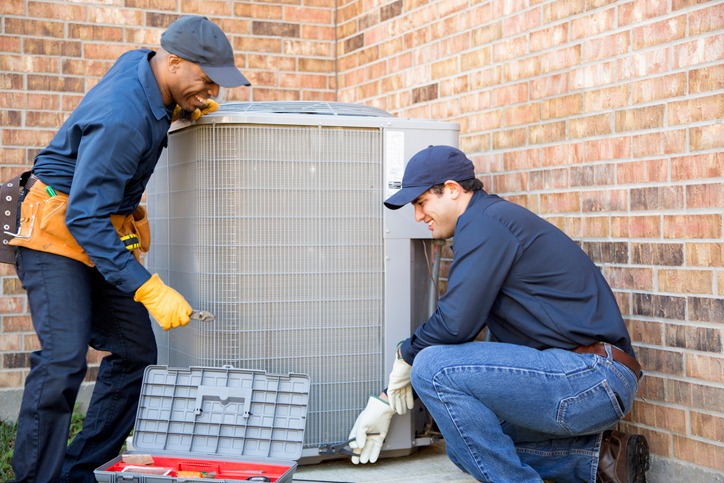
Neglecting proper air conditioner maintenance can lead to a number of issues with air quality in your home. Poor air quality can be caused by clogged air filters, which reduces the amount of air flow, leading to an increased level of dust, dirt, and other airborne particles that can adversely affect the environment. This can also cause a buildup of bacteria and mold, both of which can cause serious health problems. Investing in regular maintenance for your air conditioner is essential for ensuring good air quality in your home or business.
It’s easy to overlook the importance of proper air conditioner maintenance. But, neglecting it can have serious consequences on your energy bills. Without regular maintenance, your air conditioner has to work harder to maintain a comfortable temperature in your home, resulting in higher electricity bills. Your air conditioner needs to be kept clean and well lubricated to ensure that it is operating at peak efficiency. When filters get clogged, coils get dirty or evaporator fins become blocked, your air conditioner has to work harder, using more energy and costing you more money in the process. Regular maintenance ensures that your air conditioner is running at optimal efficiency, saving you money on energy costs in the long run.
Neglecting air conditioner maintenance can drastically reduce your system's lifespan. Without regular check-ups, the parts of your system can start to wear out faster than they normally would. These parts may need replacing sooner, resulting in a shorter lifespan for your AC unit. Regular maintenance also helps identify problems early on, so that you can take action before the damage becomes too severe. Don't let neglecting your AC maintenance result in an early replacement!
One of the most dangerous consequences of neglecting air conditioner maintenance is the increased chance of system breakdowns and emergencies. Without proper and regular maintenance, components can quickly become worn or malfunction, leading to unexpected breakdowns or even complete system failure. Having to repair or replace your air conditioning unit due to neglect can be an expensive and time-consuming process, costing hundreds or even thousands of dollars depending on the severity of the damage. On top of that, if you're dealing with a breakdown in the middle of a heatwave, you'll have to wait for a technician to be available before you can cool your home down again. To avoid having to deal with unexpected breakdowns and emergencies, it's important to stay on top of regular AC maintenance and inspections.
Neglecting air conditioner maintenance can have a number of serious consequences for your home. To protect yourself from these issues, ensure your AC unit is inspected, serviced, and cleaned regularly by our Peter Levi team of experts. Doing so will help improve your system's performance and efficiency while minimizing the risk of future breakdowns.

GM, Peter Levi Plumbing, Heating, Cooling and Drains
With over twenty years of expertise in HVAC, plumbing, and drain services, I specialize in delivering high-quality solutions for residential needs. From high-end heating and air conditioning systems to comprehensive plumbing and underground construction projects, I am committed to providing exceptional service and reliability for every household. Whether it's an emergency repair or a planned home upgrade, my focus is always on delivering the best customer experience.
If your electrical bill has been steadily increasing, you might be wondering what is causing the sudden jump. Unfortunately, one of the most common culprits is your air conditioning system. From an inefficient compressor to a faulty thermostat, there are several things that can cause your electricity bill to skyrocket. In this blog post, we will explore four of the most common reasons why your A/C system could be the cause of your expensive electrical bill.
Are you noticing that your electricity bill is steadily increasing? There could be a few culprits behind the increase, and one of the most common causes could be that your air filter is dirty. A clogged air filter can lead to a variety of problems, including high electric bills. When your air filter is dirty, your HVAC system has to work harder to push air through the system. This increased workload results in your system running longer, which means more electricity is needed to power it. This extra energy use directly translates into an increased electricity bill.

Is your electric bill soaring despite having your air conditioner running the same amount? You might want to take a closer look at your air conditioner’s refrigerant levels. If you’re not sure what refrigerants are or how they work, don’t worry – it’s not as complicated as it sounds. Refrigerants are special types of fluids that absorb heat, allowing your AC unit to cool your home. When there isn’t enough of it, your air conditioner has to work harder and longer to reach the temperature you set on your thermostat. This causes your electric bills to rise and puts more stress on your AC system, leading to potential breakdowns. If you suspect low refrigerant levels, contact a qualified technician to inspect your AC unit and determine if a refill is necessary.

Your thermostat may not seem like it’s part of your air conditioning system, but a faulty one can still drive up your electric bills. A faulty thermostat can cause your air conditioner to run continuously and may also cause it to cycle too often, using too much energy. To avoid this, make sure you check the thermostat on a regular basis. Inspect it for wear or damages, and replace it if necessary. If you’re not comfortable doing this yourself, then contact an experienced technician who can help diagnose the issue and ensure that everything is running correctly.

When it comes to explaining why your electric bill is going up, one of the most common culprits is a lack of maintenance. A/C systems require regular maintenance to keep them running efficiently and safely. If you haven't had your system serviced in a while, chances are it's not running at its best. Regular maintenance checks can help identify potential issues before they become costly problems. This could include anything from a leaky gasket to clogged air filters or ducts. Your HVAC technician will be able to tell you if any components need to be replaced or serviced. They may also be able to suggest ways for you to reduce your energy usage, such as installing a programmable thermostat or switching to more efficient lighting.

Your air conditioning system is one of the biggest culprits behind skyrocketing electric bills. When your air filter is dirty, refrigerant levels are low, your thermostat is faulty or you lack proper maintenance, your A/C system can end up using a lot more energy than it should. Taking the time to regularly maintain your air conditioning system, replace the filter and keep an eye out for signs of faulty components can help reduce your electric bill by ensuring that your A/C system is running efficiently. Ready to give your system some TLC? Our Peter Levi team is here to TAKE CARE OF IT today!

GM, Peter Levi Plumbing, Heating, Cooling and Drains
With over twenty years of expertise in HVAC, plumbing, and drain services, I specialize in delivering high-quality solutions for residential needs. From high-end heating and air conditioning systems to comprehensive plumbing and underground construction projects, I am committed to providing exceptional service and reliability for every household. Whether it's an emergency repair or a planned home upgrade, my focus is always on delivering the best customer experience.
If your home constantly feels muggy or you’re always coming down with a cold, your home’s humidity levels might be at fault. Typically, ideal humidity levels hover around 40% to 55%, and when your home’s humidity dips below or spikes above these levels, you can run into several problems. To keep your home in the best shape possible and protect your comfort, take a moment to learn more about why home humidification is essential and the five main signs you need a humidification system.
When your home has too high or low humidification levels, you can experience several issues, both to your home and your comfort. For example, if your home has low humidity levels (around 15-30% humidity), you can experience the following problems:
Besides the problems low humidity levels can create, high humidity levels (around 55-80% humidity) can also harm your quality of life and home. Some of the main problems high humidity causes include:
Since low or high humidification levels can cause several issues, it’s essential to monitor your levels and ensure your home’s air stays at around 40% to 55% humidity. Fortunately, HVAC technicians can solve the issue by installing the right humidification system for your home. However, before you spring for a humidification system, you’ll need to know you’re having humidity issues in the first place. Review the five main signs that you need a humidification system below:
Low humidity levels in your home can cause your hair and scalp to feel dry. Since dry air pulls moisture out of your skin, your skin will be more easily irritated, leading to an itchy scalp and dry, flaky skin. A humidification system can solve this problem by increasing the humidity in your home.
When you have low humidity levels in your home, your home’s air will feel drier. This dry air will cause your furnace to run longer during the winter, as dry air retains less heat than wet air. As a result, your furnace will have to run for longer periods to keep your home at your desired temperature. By fixing your humidity levels, your furnace will work more efficiently and use less energy, leading to reduced energy bills.
Dry air will have a direct effect on your wood furniture and floors. Since dry air pulls moisture from wood, low humidity levels can warp and crack your wood flooring or furniture. When you have high humidity levels, the opposite problem occurs, as your wood floors and furniture will absorb too much water from the air. These wet conditions can cause your floorboards to expand and cup. Eventually, high humidity levels can even cause your wood floors to rot.
Besides rotting your floorboards, high humidity levels can cause mold to grow in your home. Overly humid air regularly causes patches of mold to form on a home’s walls and can make your home smell musty. If mold builds up in your home, it can harm your indoor air quality, causing allergic reactions and respiratory issues. Mold growth can also stain surfaces, cause your home to smell bad, and make it easier for fungi to grow and damage your home.
Another key sign that your home’s air is too dry is if you’ve noticed a lot of static electricity or dust around your home. Since low humidity levels increase static electricity, you’ll probably notice more static shocks when you touch a metal door handle or another metallic object in your home. This static electricity will also cause dust to cling to your furniture and other surfaces, leading to greater dust build-up in your home.
If you’re looking for humidification services near you in Northern California, Peter Levi has you covered. When your home’s humidity levels are too low or high, our HVAC technicians can inspect your home and help you select the right humidification system. After you select a system, we’ll install it for you to ensure your home always has the correct levels of moisture. You can also review our coupons for our plumbing, heating, and air conditioning services to receive the best deal possible on whatever service you need.
Learn more about our humidification system services today. If you have any questions or want to schedule an appointment, please contact us.

GM, Peter Levi Plumbing, Heating, Cooling and Drains
With over twenty years of expertise in HVAC, plumbing, and drain services, I specialize in delivering high-quality solutions for residential needs. From high-end heating and air conditioning systems to comprehensive plumbing and underground construction projects, I am committed to providing exceptional service and reliability for every household. Whether it's an emergency repair or a planned home upgrade, my focus is always on delivering the best customer experience.
NOVATO
24 Digital Dr STE 1
Novato, CA 94949
VACAVILLE
1021 Mason St, STE 11
Vacaville, CA 95688
Mon - Fri. 7am - 7:30pm
Sat. 7:30am - 4pm
Sun. Closed
